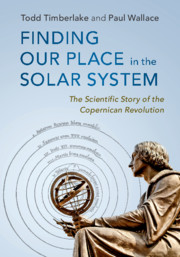Book contents
- Frontmatter
- Dedication
- Contents
- Preface
- 1 Introduction: mysterious skies
- 2 Two spheres: modeling the heavens and the Earth
- 3 Wanderers: the Moon and the planets
- 4 An Earth-centered cosmos: astronomy and cosmology from
- 5 Moving the Earth: the revolutions of Copernicus
- 6 Instruments of reform: Tycho’s restoration of observational
- 7 Physical causes: Kepler’s new astronomy
- 8 Seeing beyond Aristotle: Galileo’s controversies
- 9 The system of the world: Newton’s universal physics
- 10 Confirming Copernicus: evidence for Earth’s motions
- Appendix Mathematical details
- Notes
- References
- Index
5 - Moving the Earth: the revolutions of Copernicus
Published online by Cambridge University Press: 18 March 2019
- Frontmatter
- Dedication
- Contents
- Preface
- 1 Introduction: mysterious skies
- 2 Two spheres: modeling the heavens and the Earth
- 3 Wanderers: the Moon and the planets
- 4 An Earth-centered cosmos: astronomy and cosmology from
- 5 Moving the Earth: the revolutions of Copernicus
- 6 Instruments of reform: Tycho’s restoration of observational
- 7 Physical causes: Kepler’s new astronomy
- 8 Seeing beyond Aristotle: Galileo’s controversies
- 9 The system of the world: Newton’s universal physics
- 10 Confirming Copernicus: evidence for Earth’s motions
- Appendix Mathematical details
- Notes
- References
- Index
Summary
In 1543, Nicolaus Copernicus published a radical new theory of the heavens. He proposed that the Earth rotates on its axis while the celestial sphere remains stationary. He also placed the Sun at rest near the center of the celestial sphere, while the Earth and other planets orbited around the Sun. Copernicus’ heliocentric theory could account for the motions of the stars, Sun, and planets about as well as Ptolemy’s theory did. It also helped to explain certain features of planetary motion that were mysterious in Ptolemy’s model. However, the idea that the Earth moved was too revolutionary for most of Copernicus’ contemporaries. While Copernicus believed that his model represented the real motions of the universe, most of his readers denied the Earth’s motion and accepted Copernicus' theory as nothing more than a useful mathematical device.
- Type
- Chapter
- Information
- Finding our Place in the Solar SystemThe Scientific Story of the Copernican Revolution, pp. 107 - 146Publisher: Cambridge University PressPrint publication year: 2019



